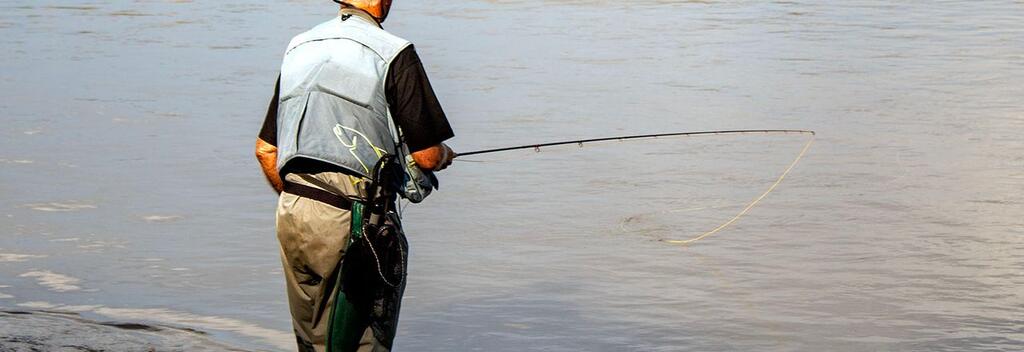-
Beliebte Ausflugsziele
Beliebte Aktivitäten
Nützliche Tipps
Hier findest du nützliche Links, die dir bei der Planung deiner Reise nach Aotearoa Neuseeland helfen.
-


Traveling to a new country to fish can be a bit daunting. Here's what you need to know about rods, clothing, flies and other gear before you leave home.
One of the things that returning anglers have come to love about chasing trout in New Zealand is that they get to fish for large sighted fish the way they like to best; floating lines, smaller dries and nymphs and where good observation, casting and stealth are all of equal importance.
With a bit of planning, you can arrive ‘river ready’, primed to learn from veteran visitors and New Zealand fishing guides alike.
All of the fly fishing lodges in New Zealand have a good supply of top brand rods, reels, waders and wading boots that guests can use, usually at no additional charge. Professional fishing guides will also supply flies.
First off, wearing drab earthy-coloured clothing is a good place to start. The wonderfully clear water that makes sight fishing in New Zealand so much fun also gives the trout a good view.
For your footwear, felt-soled wading boots are now banned from entering New Zealand to help prevent the transportation of unwanted little critters and plant spores. But never fear, rivers in New Zealand are large and generally not very slippery.
Another thing you may wish to consider is wet wading on the warm summer days with either shorts or lightweight quick drying nylon pants, which do double duty as protection against insects and brush. The majority of summer fishing is done this way as it’s a far more comfortable way to hike up and down the rivers and the water is generally not very cold - another reason why the fish can grow to much larger sizes.
By all means bring your own waders along but be aware that biosecurity staff will inspect them at the airport and may disinfect them on the spot, so it’s best to pack these where they can be easily accessed from your luggage.
As for rods, 4, 5, and 6 weights will cover all your needs on the rivers and streams; lines that are olive in colour will serve better than brightly-coloured ones. Most of the guides will even take this further and dye the front 10 or 12 feet of their lines dark brown and it’s very simple to do: hot water, some fabric dye, a pinch of salt, and 20 minutes or so. Then the front end of the line will just disappear in the water. It’s a stealthy approach to trout waters anywhere.
On the terminal end, 12 to 14-foot leaders that end with 4X or 5X tippets are the sneaky norm. A great number of common fly patterns will work as presentation, and casting accuracy are often more important than the pattern itself. Basic patterns in sizes #12 to #16 like an Adams, CDC Caddis, or some black foam creation with rubber legs would be a good place to start with the dries. As for nymphs, varieties of the pheasant tail nymph (weighted and unweighted) and the popular hair and copper are deadly, especially tied with black beads. If there's not enough time to tie your own, the local fishing stores are well stocked.
With a few seasonal exceptions, like the larger cicadas (sizes 6 to 10),the green beetles of summer (size 12) or willow grubs (sizes 18-20), the most consistent summer hatches are mayflies and caddis in (sizes 10 to 16). So basic patterns like an Adams or CDC Caddis in different sizes are both excellent. Add some little black foam terrestrials with rubber legs and you will be pretty well covered for most situations and 4X and 5X tippets will serve you well.
But when the fish are either not looking up or feeding and swinging in deeper water, variations of the pheasant tail nymph or the popular kiwi pattern, the hair and copper are both superb choices (sizes 10-16), especially when tied with black beads. Ribbing some of your nymphs with black wire will also help to dull them down for super clear water and bright days. Also, varying the weight or size of bead will help you get it to mouth level at different depths and current speeds. Add to these a size 10 stonefly nymph with rubber legs for getting down in heavy water, especially in the early season when most of the stoneflies hatch, and you’ll have your bases fairly well covered.
But if fishing the bigger river estuaries on the South Island is in your plans, you’ll want to have some muddlers and fishy looking streamers in your fly box to swing into the incoming tides on heavier tippets.
Besides these patterns mentioned, lots of others will work as well and often the answer to, “What are they taking?” is simply, “accuracy and presentation.” Professional guides will be able to provide custom and premium flies to suit – make the most of their knowledge as they’ll be able to tell you what patterns work best in their waters.
Bringing in tied flies into New Zealand is not a problem. But bringing non-synthetic fly tying materials, such as skins or necks, can cause an arrival delay as you sort it out with Biosecurity in Customs to determine if it should be fumigated or held for your departure. The good news is, most fishing stores also have good supplies of tying materials.